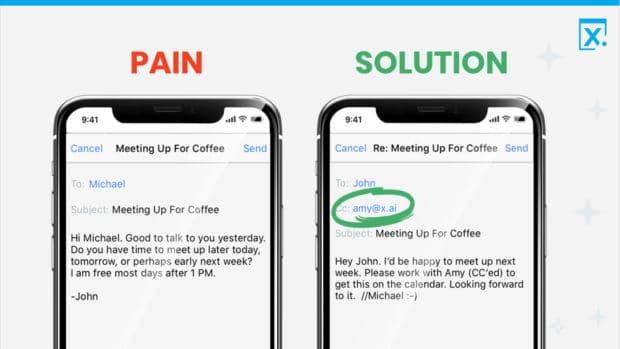Here is a look at an AI startup that raised $44.3 million in venture capital funding and built a product that has a vision to not only scheduling a “time” for meetings but also take care of every little detail that comes along. Find out how intelligent these AI assistants could be for you.
Emails will be dead. We have heard this statement in the past and many tech startups are trying to get closer to it with the help of AI. Be it someone as huge as Slack, or other newbies in the tech world that have the vision to either integrate with Slack or get funded by it eventually. It might be your end goal as an AI startup to replace emails, but studies say that there are over 3.930 billion email users, predicted to reach 4.371 billion by 2023 which is a growth of 3% yearly.
This means that emails are far from being dead, but the way we communicate through emails is going to change. And Artificial Intelligence has a major role to play in this.
One of the entrepreneurs who wants to transform the way emails reach you is Dennis R Mortensen, founder of x.ai. He is not only obsessed with the future of work and intelligent agents intertwined with AI, but his vision for the long term is also to ‘kill the inbox’. When I asked him to elaborate on what he means by this, he tells me how emails and inboxes are completely different.
“I love email. It’s one of the last free and fully democratized communications platforms out there, but the inbox (which is different) is many times a bucket of chores and anything we can do to remove those chores – the better it is. We do the meeting scheduling email back and forth, so you do not have to.”
Dennis is the man behind these two: Amy and Andrew – the artificially intelligent assistants who schedule meetings for you and there is a high probability that someone receiving emails would never know they are not humans. It has happened to me!
Why Amy+Andrew as AI assistants?
Rakesh Chada and Marcos Jimenez, data scientists at x.ai. explain how this works, “We’ve built a virtual assistant (it goes by the name of Amy or Andrew) who can be cc’d into your typical request to meet with people over email. Amy will “understand” the handover and just take it from there with your guests, following up with them to nail the time and location details for the meeting. Just like a human assistant would.” Under the hood this means that Amy must automatically extract meeting-related pieces of information from your email and mashing that up with your calendar and overall preferences, proceed to get your guests to agree to a time that works for you and them, plus gather whatever other details are needed for the meeting (phone conference number, meeting room, address, google hangout link, etc …). That’s the premise of the product.
To me, this seems like a dream which might be achievable too, but with it comes quite a few bottlenecks, which Dennis agrees to as well but is determined that it is a matter of time that the product will become scalable. Keep reading.

Dennis never had the ambition of creating an AI company though. All he wanted to do was solve a pain that many didn’t know how to get rid of and that gave birth to his meeting scheduling software company. “I think as an entrepreneur one should never really fall in love with the technology. The more important thing to obsess over is the pain that one’s customer might be in and how you could solve it.”
He knows customers are not willing to pay 40,000 euros a year to have an assistant sit in their front office and fiddle with their calendars. But he also knows customers feel this pain and his massive co-ordination network via the assistants could be the onset of what cloud storage was at a decade ago.
It is a no-brainer that an AI assistant scheduling meetings could save time across geographies. Imagine a scenario sitting around at 10:00 pm somewhere in the United States trying to reschedule a meeting with someone in Europe. Why wait for someone to reply in nine hours? “This should have been an instant reschedule turned into an 18-hour moment in between,” says Mortensen. It is not just individuals but also companies that have seen value in it.
Kevin Groat, Sr. Global Technical Enablement Manager at VMWare says, “The recent enhancements (my favorite is being able to instantly schedule with coworkers) are elevating Amy and Andrew to true Enterprise-class virtual citizens, who haven’t forgotten their SMB roots. This, along with the ease of incremental adoption, automation and price point make x.ai an easy choice to streamline inefficient, legacy scheduling practices, “
Founded in 2014 by Dennis and two others Alex Poon and Marcos Jimenez Belenguer, the AI meeting scheduler has to date raised $44.3 million in venture capital. With the conviction that any company would be interested in bundling up his software with the other must-haves that employees receive from enterprises, Mortensen is aiming at x.ai’s market penetration to rapidly pick speed.
Pricing decisions and other challenges with AI
Changing the behavior of consumers is the biggest challenge for x.ai. You need to be convinced that you don’t need employees to waste their time on meetings but rather have a tool with just $8 per month for those employees. “There needs to be a slight change of behavior, but I think it’s happening as we speak, so time will solve that. I just want to make sure that it happens fast enough,” says Dennis.
The pricing of the software went from $8 as the lowest offer early this year to now being free. When I spoke to Dennis previously this year, he mentioned that after continuous testing for 14 to 15 months, he had zeroed on $8 pricing as a fair value where he believed the New York-based company had entered the territory where everybody sees x.ai as just another software that every organization uses similar to G-Suite and not as an add-on service that may not find many takers. However, the company also launched a free version on September 9 this year and Dennis says this has led to the fastest user growth ever. “By lowering costs per user and increasing the utility of our system via network effects, we are able to offer x.ai for free,” he says.
The second challenge is mistakes that Amy or Andrew might make while fixing meetings for different users.
“No prediction in the world, whatever you want to predict will forever be a 100% correct all the time. No meeting scheduling agent, no movie recommendations on Netflix — there’ll always be some error.”
Sometimes it doesn’t matter much, and sometimes it’s a complete catastrophe. “Our accuracy is above 95%. Sometimes it is not enough so we are are still working on it with the design approach. We can have our customers kind of help us to verify little details. Like once you ask Amy to do something, she’ll read it back to you.”
Ammom Brown, the Growth head of x.ai says that the company had a huge amount of feedback on how often and how many times Amy and Andrew should reach out to an unresponsive guest. In some cases it would seem to be a bit overzealous, in other cases, they would be too timid. “Years of tweaking the logic got us no closer to a happy compromise, so we made some big changes recently to help you manage to follow up emails on a case by case basis, ” and this continues.
To outpace rivals, x.ai is working on two aspects. High accuracy on the host’s end as in the customer where anything which the user asks Amy to do, she understands accurately every time. And second on the guest end, where anything that the guest wants to do, they could do without really any fail or feeling annoyed. There has been a lot of debate about how AI assistants are not the best user experience and don’t feel “human” enough.

The x.ai team in the New York office
Channel integrations and road ahead
Direct integrations with x.ai at this point include MS Office, MS Team, G Suite, Zoom and few others through Zapier. With nearly 20 employees working on making x.ai more accurate, the startup will expand via two interesting integrations besides generic integrations such as powerful platforms that allow a ton of vendors to stick to each other.
One by channel integrations; say WeChat in China or Facebook messenger or WhatsApp or wherever people talk about meeting up. The second will be into other things that come along by fixing a meeting. Example conference systems like Uber, Hangouts, Zoom, and other resource systems such that Amy can book conference rooms. At present, it offers the ability to book conference rooms in G Suite and MS office. Dennis wants to make sure that anything that comes along with setting up meetings like iterations should be done by Amy.
Amy is now able to able to login to a person’s Zoom account, pull out a URL, attach that to a meeting. At the same time, if the consumer wants to book a meeting room for this call, Amy is be able to look for the resources to find the meeting room and book at the same time.
The company does not want to limit itself to one language or just setting up meetings. “We do want to be multilingual so that this can exist in German for German speakers or in Spanish or in some version of Chinese, says Dennis. He sees his company solely focused on getting that event on the calendar and making it as fast as possible.





